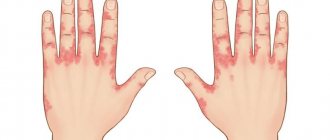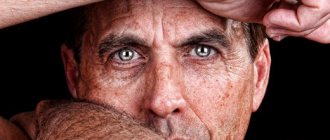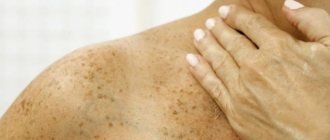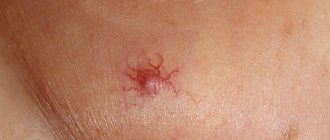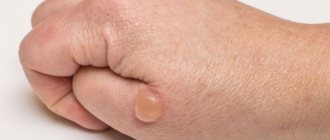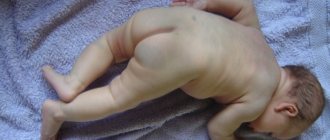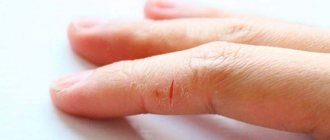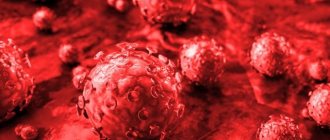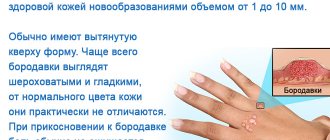Sometimes dark spots of unknown origin appear on the legs. Whether they are dangerous or not, only doctors can answer this question. You need to immediately undergo an examination, find out the cause of their occurrence, and how to get rid of them.
Are you having any problem? Enter “Symptom” or “Name of the disease” into the form, press Enter and you will find out all the treatment for this problem or disease.
The site provides reference information. Adequate diagnosis and treatment of the disease is possible under the supervision of a conscientious doctor. Any medications have contraindications. Consultation with a specialist is required, as well as detailed study of the instructions! Here you can make an appointment with a doctor.
What can the color of the spots tell?
Bruising is sometimes caused by factors that a person does not notice or is not aware of.
Bruises can appear on their own when a person is asleep and does not control his actions. An unsuccessful turn of the body during sleep can lead to a bruise of the head or soft tissues - a hematoma is formed. When moving quickly, coordination is disrupted and microtrauma occurs from hitting furniture or other objects. There are people who have sensitive skin from birth and bruises appear even from slight finger pressure. In such cases, nothing can be done, just try to control your movements.
Multi-colored spots on the skin indicate the health of the body. The external manifestation of signs in the form of spots makes it possible to diagnose many diseases in time, preventing them from developing into a chronic form.
Dark spots
Dark brown manifestations on the skin that do not have clear outlines, called pigmentation, may indicate a disease of the endocrine system, liver, kidneys, or tuberculosis.
Light spots
Neoplasms of light shades draw attention to the fact that the skin is infected with some kind of infection or autoimmune transformations are occurring in the body.
Yellow spots
Yellowness of the skin indicates that the body has increased secretion of bilirubin, which causes jaundice and other liver diseases.
Red spots
Redness of the skin may indicate the development of infectious diseases, vitamin deficiency, decreased immune defense of the body, dermatitis, and allergic predisposition.
Brown spots
Darkening of skin areas may indicate the development of a complex form of dermatitis - photodermatosis, as well as age-related pigmentation.
Causes of purple spots
Most often, such pigmentation on the skin is caused by rupture of blood vessels or capillaries. For example, an ordinary bruise appears after a severe injury. In some cases, purple spots are observed due to serious diseases. These include capillary toxicosis, purpura and other diseases. The main difference is that a bruise appears after mechanical or forceful impact. Purpura appears for no reason and does not go away from the skin for a long period of time. Small capillaries may be present on the spot. Most often, purple spots in medical practice are also found on the knees, forearms and hands.
Purpura, or subcutaneous blood leakage, is diagnosed when a port-wine stain persists over a long period of time. The condition is considered one of the symptoms of scurvy or poor skin clotting. In old age, pathology manifests itself due to the thinning of the walls of blood vessels. The situation often occurs due to the use of large amounts of vitamin E and other medications.
If you have extensive purple spots that do not go away over a long period of time, you should visit a dermatologist. A doctor's examination will be required if bruises appear periodically in the absence of external influences. Purple spots on the skin may indicate the presence of pathologies in the vessels and capillaries.
—Categories
- Articles (10)
- Practice (6)
- Pathologists (4)
- Medicine (3)
- From thin. literature (3)
—Subscription by e-mail
—Search by diary
—Interests
— Regular readers
-Statistics
Sunday, January 27, 2008 1:58 pm + to quote book
Signs of life and death. Clinical and biological death
In case of severe injury, electric shock, drowning, suffocation, poisoning, as well as a number of diseases, loss of consciousness may develop, i.e. a state when the victim lies motionless, does not answer questions, and does not react to others. This is the result of disruption of the central nervous system, mainly the brain. The person providing assistance must clearly and quickly distinguish between loss of consciousness and death.
The onset of death is manifested in an irreversible disruption of the basic vital functions of the body, followed by cessation of the vital functions of individual tissues and organs. Death from old age is rare. Most often, the cause of death is disease or exposure to various factors.
2. Warning sign: skin cracking in the sun
In fact, an allergy to sunlight is extremely rare (unless you're a vampire!). However, with some people their immune system can play such a cruel joke. A more realistic explanation of the causes of skin inflamed in the sun, which becomes covered with a rash like eczema,
. In fact, we are talking about the components contained in some medications. They are the ones that can increase a person’s sensitivity to light. Experts also believe that this phenomenon is typical for northerners who do not experience any problems throughout the winter, but begin to suffer from a specific rash in the summer.
Sun marks
Causes of dark spots:
- After tanning, dark patches may appear on the skin due to excess melanin production.
- The cause will be various diseases of the internal organs.
- Doctors do not advise people with liver disease to stay in direct sunlight for long periods of time.
- If there are problems with the thyroid gland, then there is a high probability that this is the cause of increased pigmentation.
5 useful tips to help avoid pigmentation:
- While on vacation at sea, stop taking hormonal medications.
- Do not use antibiotics.
- Before sunbathing, it is forbidden to use perfume.
- Preference should be given only to reliable tanning products.
- Do not take sedatives.
Warning sign: brownish spots on the lower leg
This is how a person is designed that he periodically (mainly through inattention) kicks into objects that get in his way. Most often, the front part of the leg along the shin is affected. When healthy, everything heals without problems!
, the pattern of damage to capillaries and small blood vessels can tell a lot about his disease. In such a person, such damage can lead to the so-called leaky blood vessels, which is expressed in brown pigmentation, known as diabetic dermopathy.
7. Alarm sign: purple patches and isolated spots
Anything that even slightly resembles bruises is often identified with them, but this is not always the case. The cause may be a so-called purpura (hemorrhagic rash), which causes the blood vessels under the skin to “leak.” There are several reasons for this, including:
. However, in people over 65 years of age, in whom the disease is most common, thinning skin may be the cause. Over the years, the skin's resistance to sun exposure also decreases, and the walls of blood vessels weaken. This phenomenon is known as “senile purpura.”
Types of neoplasms on the skin
When various kinds of problems occur in the functioning of any internal organ, the skin is one of the first to begin to react to such disturbances, and in some cases such a reaction is observed in the form of spots of different colors appearing on its surface. Purple or blue spots can form on the epidermis as a result of a violation of the integrity and structure of surface capillaries, however, in some cases, such neoplasms indicate the development of some serious pathological process in the human body. If blue spots on the body appear for no reason and are multiple in nature, then this is the first signal of the need to consult a specialist.
Macules, or skin spots, can appear on almost any part of the epidermis and have a variety of colors, ranging from flesh-colored to dark purple or brown. All macules are divided into:
The main reason for the occurrence of such skin tumors is a disruption in the production of melanin in a certain area of the epidermis. Thus, light or flesh-colored maculae are often one of the signs of excessive exposure of the human body to sunlight. This phenomenon mainly occurs among people who often vacation at seaside resorts. However, in addition to this, the causes of the appearance of light-colored spots on the skin can be all kinds of skin pathologies of a fungal nature, the development and progression of which disrupts the processes of normal production of melanin, a skin enzyme whose function is to regulate the color of the epidermis.
8. Warning sign: constant itching without rash
Dermatitis herpetiformis is a cluster of small, terribly itchy blisters that often appear on the forearms near the elbows, on the knees, buttocks, back, face and even on the scalp. In essence, we are talking about celiac disease, or an allergy to gluten. In fact, every fourth person suffers from this disease to one degree or another.
In general, itching, which is felt on various parts of the skin, can be caused by numerous reasons. However, if no skin rash or discoloration is observed,
(tumor arising from lymphoid tissue). In fact, there are two main types of lymphoma - Hodgkin's disease (chronic malignant lymphomatosis) and non-Hodgkin's lymphoma.
Such specific manifestations often indicate the presence of shingles (herpes zoster). This disease can be caused by certain viruses that also cause chickenpox. Eight out of ten patients who have had chickenpox have
. However, events such as stress or infections, as well as taking certain medications (particularly those needed during chemotherapy or after organ/tissue transplantation), as well as the deterioration of the immune system with age, can reactivate the virus, resulting in the appearance of shingles.
Causes of purple spots
In most cases, the bluish or purple tint of the skin tumor is of vascular origin. In this regard, this kind of spot on the epidermis can arise as a result of mechanical damage to one of its areas, which also causes damage to the structure of the surface capillaries. Mechanical damage to one or another part of the epidermis occurs due to injury or bruise. However, in some cases, the appearance of purple macules may indicate the occurrence of various pathologies in the human body that affect its vascular system. Such diseases include meningococcemia, thrombocytopenic purpura and capillary toxicosis. Most often, purple macules appear on the inner surfaces of the hands, forearms or ankles of a person.
If this kind of spots does not disappear over a sufficiently long period of time, then this is not a bruise, but subcutaneous damage to the capillaries, during the development of which blood leaks from the damaged blood capillary. In older people, the appearance of such port-worn macules is facilitated by age-related changes in the circulatory system, which are characterized by thinning of the walls of capillaries and blood vessels. This phenomenon is called senile purpura.
In addition, the formation of purple skin spots occurs against the background of too much vitamin E consumption, various non-steroidal anti-inflammatory drugs, any blood thinning drugs, and as a result of excessive consumption of alcoholic beverages.
Other more serious causes of wine-colored skin growths include:
- the presence of any diseases affecting the liver;
- rheumatoid arthritis;
- leukemia - blood cancer;
- marbled skin syndrome;
- flaming nevus;
- Fabry disease;
- Kaposi's sarcoma;
- Cobb syndrome.
If wine macules are large in size and do not disappear over a long period of time, you should immediately contact a specialist.
How to remove spots on skin?
To cure a skin rash, it is necessary to eliminate the cause of its appearance. If skin rashes in the form of red spots appear due to an allergic reaction, eliminate the allergen; if due to an infectious disease, cure it. In some cases, spots on the body are signals of the development of a tumor or serious pathology of internal organs, so consulting a doctor is not only desirable, but mandatory.
You can whiten brown spots on the body if they are harmless freckles or hyperpigmentation caused by long exposure to the sun. Other types of this defect will disappear when the underlying disease is eliminated. Several methods are used to combat hyperpigmentation:
- decreased melanin formation;
- exfoliation of the top layer of skin;
- protection of exposed parts of the body from solar radiation.
Treatment is carried out as follows:
- In order to speed up the desired effect, bleaching agents are used.
- To reduce the synthesis of melanin, drugs with hydroquinone and azelaic acid are used.
- To reduce the amount of tyrosinase, an enzyme involved in the formation of melanin, products with arbutin and kojic acid are used.
- Preparations with salicylic acid, arbutin, eugenol and some other components also cope well with pigmentation.
Spots on the body of allergic origin are treated with antihistamines and traditional medicine.
Treatment for skin allergies:
- If urticaria appears, you can take Suprastin, Claritin, Zyrtec, Tavegil or another drug.
- When allergic red spots on the skin itch, you can use Gistan in the form of an ointment or cream, homeopathic ointment Iricar, zinc ointment. Hormonal medications for allergies are prescribed by your doctor.
- An effective folk remedy for allergic rashes is raw egg shell powder. Take a third or a quarter of a teaspoon, quenching it with lemon juice.
Treatment of deprivation
Each type of lichen requires a special approach - there is no general therapeutic regimen. Only a dermatologist can prescribe adequate treatment.
Because dry patches on the skin are often itchy and itchy, doctors recommend:
- Take antihistamines - Tavegil, Suprastin, Zyrtec.
- It is impossible to lubricate the affected areas with potent drugs (iodine, salicylic acid, sulfur ointment) - this will cause a worsening of the condition.
- It is forbidden to steam damaged skin and expose it to sunlight.
Dark spots on the body of unknown origin cannot be treated on your own - these can be manifestations of serious diseases.
Common hematomas (bruises) can be treated at home:
- Bodyaga - pharmaceutical powder is diluted with water and a compress is made.
- Iodine - an iodine mesh is applied to the hematoma.
- Lead lotion - you can buy it at the pharmacy and make compresses.
- Heparin ointment - it relieves inflammation and swelling, promotes rapid resorption of the bruise.
It's not often that you find perfectly smooth skin. In modern living conditions this has become almost impossible. Many people do not take seriously the presence of small scars, moles, spots on the skin, but often this condition is pathological. And besides, a psychological problem arises - a person is embarrassed in front of others and begins to look for different means to eliminate the aesthetic problem.
Red spots, white, black, brown or bluish on the skin sometimes indicate the presence of diseases, infections, allergies and other problems. Therefore, any unusual appearance of a skin lesion should alert you.
At a minimum, you need to monitor changes in the problem area and think about visiting a specialist for consultation and the necessary treatment.
Formations are dry and flaky
Dark spots on the skin occur in several cases. They can occur due to hormonal changes in a pregnant woman. The spots are dry and flaky.
There's no need to panic. This will go away immediately after the baby is born.
Spots also appear in older people. It's not dangerous at all. This phenomenon is normal. In other cases, such spots may arise from hypothermia. Or it could be a fungal infection.
To get rid of unpleasant spots on the body, you need to find out the reason why they arose, and then begin treatment. Treatment must be prescribed by a doctor.
Self-medication should be excluded immediately. If you have a serious illness, you can only make the situation worse. Which will lead to more severe complications.
Lichen
Symptoms of many infectious diseases are reduced to the appearance of spots on the skin. Ringworm is very common. It has both fungal, bacterial and viral etiology, and can manifest itself due to weakened immunity and hereditary predispositions.
Experts determine the type of lichen by the characteristic signs of spots on the skin.
- With pityriasis versicolor, yellow and brown marks with a crust appear on the body.
- With pityriasis rosea - round pink with a red border, flaky.
- With shingles, red inflammation resembles an allergic rash with blisters, which is localized along the nerve trunks on the back, under the ribs.
- With lichen planus, the neoplasms look like nodules that connect with each other, forming large-scale foci of inflammation.
- With lichen alba, white spots appear without clear boundaries.
- Ringworm is characterized by the formation of shapeless bald patches on the head.
The symptoms of lichen are very similar to the rash associated with chickenpox, measles, and rubella. Sometimes lichen is confused with eczema and allergic skin dermatitis.
Pigment
Pigmentation can be either white or brown. In addition, doctors distinguish:
- natural pigmentation, which occurs due to the influence of ultraviolet radiation on the skin - tanning, thus melanin protects the skin from burns, cancer, dermatoses;
- melanin pigmentation associated with excess and deficiency of the main pigment.
An imbalance in melanin production makes itself felt when:
- hormonal disorders;
- during pregnancy;
- taking hormonal medications;
- the onset of menopause in both women and men;
- skin aging;
- genetic inclinations;
- infectious infection.
With an excess of melanin, the appearance of hyperpigmented spots is characteristic:
- congenital – moles (nevi), lentigo, birthmarks;
- acquired - age spots (senile lentigo), freckles (ephelides), chloasma.
Most often, pigmentation is localized on the face, décolleté, and hands.
Main types of skin spots
Purple spots on the skin are scientifically called macules. Color can vary from pink, blue, wine to dark purple. In some cases, additional peeling is observed on it.
All spots on the human body can be classified according to the following criteria:
- present on the skin from birth;
- pigment formations;
- acquired during life;
- caused by rupture of blood vessels or capillaries.
They also differ from each other in color. Most often, the reason lies in a violation of natural pigmentation. Light coloring appears when a person spends too much time in the sun. People often encounter this problem during their vacation at sea.
Doctors note that this symptom is characteristic of human skin in the presence of the harmful effects of a fungus. Some diseases disrupt the production of melanin, so changes in skin color are observed. From birth, such spots can be diagnosed with albinism. Moreover, in addition, a person’s hair and iris are white.
Nevi or moles are purple or wine-colored spots that are either present on the human body from birth or appear throughout life. Their independent removal is not allowed, since in this case the risk of its degeneration into a malignant neoplasm increases.
When directly exposed to sunlight, freckles tend to change color to purple. In this case, in winter and autumn, they almost completely disappear from the face and body. Their manifestation next year will begin during the period of increasing solar activity. Dermatologists note that with age they will appear less and less.
During pregnancy, brown or coffee-colored spots periodically appear on a woman’s body, which in medical practice are called chloasma.
In older people, age spots appear due to liver dysfunction. They have a slightly brownish color. When exposed to direct sunlight, their size can increase several times. The spots are located on the face, arms and body. Dermatologists note that they do not harm human health, but are a simple external defect.
Black rashes appear in some people as they age. They can also be located on the neck, groin and armpits. Most often, this manifestation is considered a symptom of pathologies in the functioning of the adrenal glands or pancreas (diabetes mellitus).
Preventing skin blemishes
Skin is an indicator of people's health.
Small inflammatory foci in the form of spots tend to develop into large ulcers and wounds, so caring for it should be as follows:
- compliance with hygiene standards;
- the use of non-aggressive cosmetics and detergents;
- avoiding contact with external irritants - using gloves, masks, respirators in everyday life;
- maintaining a healthy lifestyle - giving up bad habits, normalizing sleep and activity patterns;
- compliance with the diet;
- taking fortified courses;
- frequent walks in the fresh air;
- minimizing the effect of ultraviolet radiation on the skin;
- normalization of mental state;
- preference for relaxation activities;
- choosing wardrobe items made from natural fabrics.
The implementation of the above preventive measures is mandatory for frequent relapses of the spotty problem. Following a healthy lifestyle is much easier than finding the root cause of skin diseases and eliminating them.
Rashes and spots on the body are unsightly and often feel unpleasant. In addition, rashes can signal serious illnesses, so it is necessary to be able to distinguish between common hives and chickenpox, redness caused by the weather, and lichen.
Burgundy spots on the hands of older people
What are the harbingers of purple spots on the skin? Should we be afraid of them? Can we ignore them? What are the factors in the development of this unusual phenomenon and how does skin damage occur in adults and children?
Subcutaneous hemorrhage is a common consequence of a mechanical shock, but the appearance of a wine-colored rash for no reason suggests that something is wrong with your health.
Types of rashes and the risks of their occurrence
Before you understand what it is and how it affects the body, it is necessary to describe the types of rashes, which differ in structure and color saturation.
Blue pigment formation can occur both from birth and after it. Acquired spots form at any age and are often associated with a blood clotting disorder.
There are 2 types of lesions:
- internal (develop due to disorders in the body);
- external (formed under the influence of mechanical stimuli).
In addition to injury, external causes are also associated with exposure to extremely high temperatures. If boiling water gets on the skin, the surface is scalded, so along with the bubbles a red and then bluish tint appears. “Marks” formed due to negligence remain for life, although they gradually fade over the years.
- long-term use of hormonal drugs;
- excessive intake of vitamin E;
- abuse of blood thinning medications (aspirin);
- alcohol addiction;
- excessively heavy physical labor;
- standing on your feet for a long time (risk of injury to the lower extremities).
If a purple or blue spot under the skin is found after childbirth, a birthmark is diagnosed. Acquired forms also include vascular nevi, since pigmented formations extremely rarely have a lilac tint.
Blue spots are a common consequence of overzealous cupping. The restoration of the natural shade occurs after 5–7 days.
Marbled skin syndrome - livedo
Livedo is the disease that develops in patients (medical term) who suffer from suddenly appearing bluish-purple streaks on the skin. Secondary disease is diagnosed mainly as a consequence of damage to internal organs and other pathologies.
There are other names for the disorders. One of them is livedo reticularis, which occurs due to atypical microcirculation. It most often occurs on the legs, less often on the torso.
Dangerous conditions - what are they?
Excessive rashes on the back, as well as other parts of the body, are a sign of a complex disorder in the body. During this period, they refuse to visit the bathhouse and sunbathe.
Diseases with a risk of acquiring disability:
- Thrombocytopenic purpura. The disease is dangerous due to the risk of internal hemorrhages, including in the brain. Laboratory confirmation of purpura is an extremely low number of platelets in the blood. Vascular dysfunction is often inherited, but sometimes occurs spontaneously.
- Capillary toxicosis. A sharply manifested symptom is the result of the entry into the body of an allergen (usually a food product) to which the person is intolerant. It often develops in children as a hypertrophied reaction to sore throat.
- Venous dilatation of veins (from stage 3). Although the defect appears in many patients in old age, the greatest risk is in those who have a complication. Advanced varicose veins lead to the appearance of dark areas of the dermis, which sometimes turn black. In this case, immediately consult a doctor: a change in shade is a symptom of necrotization. Appears in the arm area in 5% of cases.
- Kaposi's sarcoma. A malignant process that spreads chaotically throughout a person’s integument. the danger is the rapid degeneration of small “marks” into 5-centimeter (in diameter) nodes.
A small red rash, especially in the legs, is sometimes the initial stage of thrombocytopenia, but more often the phenomenon occurs due to excessive exercise.
Intensive scratching of the skin with nails can also cause pinpoint but harmless changes. If vascular tone is disturbed, then formations - red moles - can remain on the body for a long time.
Facial erythema causes redness of the epithelium, and its complicated form causes a purple tint to the damaged dermis. Sharp but temporary changes are also possible with the development of drug photosensitivity in the chronic stage.
In the photos attached to the article, it is easy to determine which rashes appeared due to the oncological process, and which due to vascular pathology.
Age factor: children and elderly
Large purple spots on the skin of older people quickly form even with small impacts, since the walls of blood vessels become irreversibly thin after 50 years. Another defect is formed due to liver pathology, although the color of the spots is often brown rather than purple.
Thrombocytopenia also affects pensioners - this condition is called senile purpura, in which minor hemorrhages are diagnosed even without receiving a blow or the influence of other mechanical influences.
Anxiety grows when a rash is detected in a child, but pediatricians attribute most disorders to temporary defects. Rashes often appear due to a previous illness (cold), and the formations themselves always have a pale tint.
When a bright purple rash occurs, there is a risk of developing purpura. The most dangerous condition is meningococcemia, which develops due to sepsis. Children infected with the infection often die.
A bruise-like rash is also found with nevus flammosa (its congenital form). Damage appears in the womb, so they are immediately detected by obstetricians after birth.
The damaged structure of the baby's epithelium is not restored as it grows up, and sometimes it deteriorates even more - it turns darker. Conditions for deterioration: injury, excitement, infection.
Harmless blue spots on the baby's body appear after birth. They are located in the sacral area, sometimes on the butt, since excess melanin accumulates in a small body. The medical name is Mongolian spot, which is also diagnosed in representatives of other races. The skin defect disappears without a trace by the age of 2 years.
Spider veins are a normal variant in the elderly. The older the body, the less tone the circulatory system has.
Conclusion
Wine rashes often indicate serious health problems. Immediate contact with doctors is indicated when purple spots suddenly appear on the legs: there is an increased risk of blood clot formation.
Doctors warn! Shocking statistics - it has been established that more than 74% of skin diseases are a sign of parasite infection (Accarida, Giardia, Toxocara).
Worms cause enormous harm to the body, and the first to suffer is our immune system, which should protect the body from various diseases.
The head of the Institute of Parasitology shared the secret of how to quickly get rid of them and cleanse your skin, it turns out that’s enough. Read more .
If you take preventive measures in time (smear your feet with Troxevasin, avoid a sedentary lifestyle, avoid injuries), then dangerous consequences can be effectively prevented.
The human body is designed in such a way that with any disruption of homeostasis, visible changes occur that become noticeable to the naked eye. Moreover, in such a category of patients as bedridden patients, homeostasis is disrupted due to the formation of bedsores.
This process develops gradually, from minor changes in the skin to huge and deep wounds that are extremely difficult to heal.
However, the spots on the body of a bedridden patient vary in color and clinical formation and can indicate not only the formation of bedsores.
Source: https://medicskin.ru/bordovye-pjatna-na-rukah-u-pozhilyh-ljudej.html
Skin spots - causes
The skin is the largest organ of the human body, so any changes on its surface should be taken seriously. Spots on the body are areas of the skin that differ from the rest of the skin in color, density, etc. Doctors identify the following types of skin spots:
- pigment spots - spots that appear as a result of an imbalance of melanin;
- vascular – appearing as a result of diseases of the cardiovascular system;
- artificial - resulting from exposure to coloring substances - paints, makeup;
- spots that appear as a result of skin diseases - dermatoses, allergies, lichen.
Redness on the skin may indicate dermatitis, infectious diseases, decreased immunity, allergies, and abuse of sun treatments. Skin allergies are red spots that can be small or large, spreading over large areas of the skin. Hives can appear and disappear, change location. Sun exposure causes small red, itchy spots to appear on the skin.
Red, scaly patches on the body are a symptom of psoriasis. With this disease, convex, scaly spots of round or irregular shape appear, covered with gray-white skin scales that crumble. The disease is characterized by severe itching; if the thin film under the flaky layer is damaged, “bloody dew” may appear. Localization of plaques in psoriasis - on the head, arms, folds (elbows, knees, armpits).
Red spots on the body may indicate the presence of a fungal, viral or bacterial infection in the body. Such rashes and spots on the body often appear as a symptom of the disease. It could be:
- measles – a maculopapular rash that merges into large spots;
- rubella - a papular rash that is not detectable by palpation;
- chicken pox – papular rash, small individual rashes;
- Scarlet fever - red raised pimples.
Bright or pale pink spots on the body may indicate an allergic reaction to medications, foods (citrus fruits, dairy, sweets) or cosmetics. Scaly patches on the skin may turn out to be pityriasis rosea, the distinctive feature of which is the symmetry of the location of the rash.
Spots on the body that look like pityriasis versicolor are pityriasis versicolor, which can be yellowish-brown or lilac in color. The causative agent of this disease is the fungus Pitisporum. First, the patient develops small spots, which then merge into a large formation. This disease is contagious and can be transmitted by contact or through hygiene items (towels, napkins). The risk of getting sick increases in the presence of chronic diseases and excessive sweating.
Brown spots on the body are melanosis - a disorder of melanin synthesis, which causes excess pigmentation. Pathologies that cause age spots on the body:
- liver diseases - cause small areas of the skin to turn brown;
- disturbances in the functioning of the endocrine system - cause a failure of metabolic processes, which leads to the appearance of age spots;
- tuberculosis – also leads to pigmentation disorders;
- Problems in kidney function lead to the development of uremic type melanosis.
Melanosis can be caused by prolonged contact with toxic substances - coal, oil and others. People who work with toxic substances are at risk of a disease such as toxic melanosis. Workers who frequently come into contact with arsenic may experience arsenic melanosis.
Leopard syndrome is a rare genetic pathology that is characterized by the appearance of many pigment spots on the body. The appearance of this syndrome may signal that it is necessary to check the functioning of the cardiovascular and respiratory systems. Brown spots on the skin that look like moles are lentigo. This disease can be caused by a malfunction in the immune system, gene mutations, or the activity of the papilloma virus.
Dubreuil melanosis may indicate oncology. At the initial stage of this pathology, a spotted brown rash appears. Over time, irregularly shaped spots grow and become similar to the drawing of a contour map; later, the formations become dense, papules and nodules form, which can become a malignant tumor.
A symptom such as white spots on the body can indicate diseases of internal organs, injuries, fungal infections, a malfunction of the immune system, hormonal imbalance and other problems. Leukoderma is a disease in which melanin production stops or becomes insufficient. The symptom of the disease is small round white spots on the skin. The appearance of irregularly shaped white spots is a symptom of vitiligo, a serious and poorly understood disease.
White spots on the skin after sunbathing appear due to:
- vitiligo;
- fungal skin infections;
- diseases of the liver, kidneys, adrenal glands;
- hormonal imbalances;
- genetic pathology;
- immunity failure;
- infectious diseases - syphilis, leprosy and others;
- the presence of scars and scars.
The appearing hematomas themselves are a symptom of some serious diseases:
- liver dysfunction, leading to blood thinning and bruising;
- varicose veins - with this disease bruises appear on the legs;
- hemorrhagic vasculitis - an autoimmune disease in which the walls of blood vessels are destroyed;
- vitamin deficiency, which makes blood vessels fragile;
- bleeding disorders due to a lack of platelets or certain medications.
Dark spots on the skin that look like purple or blue bruises may be:
- angiokeratoma - a benign vascular formation;
- thrombocytosis – purple spots appearing due to an increase in the number of platelets;
- flaming nevus - wine-colored spots that arise due to damage to blood vessels located close to the surface;
- Kaposi's sarcoma - a purple spot similar to lichen, which is a signal of tumor development.
There is no need to see a doctor if the hematoma after a bruise or injury does not bother you and goes away in 2-3 weeks.
Tests, medical care and consultation are required in the following cases:
- Bruises often appear for no apparent reason.
- The spots do not go away for more than a month.
- Bruising is accompanied by additional symptoms.
- The area of injury is painful or swollen.
- The bruise is huge and there is pressure or pulsation in it.
- Signs of infection around the spot are fever, pus.
Can be localized between the legs
Darkening of the skin between the legs and other parts of the body may appear.
Their occurrence is due to a disruption in the functioning of blood vessels or due to pigmentation of the skin.
Changes in skin color on the legs are classified as age spots, which are often found in people.
Only the attending physician can identify the cause and prescribe treatment. There is no need to self-medicate, because there are many causes of pigmentation on the lower extremities and each of them requires individual treatment.
- Increased production of melanin leads to the formation of brown spots on the skin. The shade depends on the amount of pigment produced.
- Due to the use of modern methods of hair removal on the legs, darkening occurs due to malignancy, that is, malignancy of age spots.
- Pathological disturbances in the functioning of the body indicate the development of several diseases, which leads to increased pigmentation. The list of diseases is huge - from lichen to vitiligo. The doctor selects treatment depending on what caused the pigmentation on the legs.
- Malfunctions in the functioning of the circulatory system.
- In case of insufficient intake of ascorbic acid into the body, rutin.
- Diseases of internal organs.
- Insufficient physical activity leads to weakening of the walls of blood vessels and causes pigmentation on the skin in the form of dark spots.
- If the vessels are located close to the surface of the skin.
- Taking medications that cause blood vessel destruction.
- For varicose veins.
Patients often make the mistake of thinking that the change in pigmentation was due to an allergy. If it does not go away after avoiding contact with the allergen, you can be sure that the cause is something more serious than an allergic reaction.
Pigmentation disorders are accompanied by severe itching.
Vascular
Vascular spots have a pink, purple, purplish-red hue. They are classified into the following types:
- hyperemic:
- hemorrhagic;
- telangiectatic.
Hyperemic, in turn, is divided into:
- inflammatory spots filled with blood, resulting from inflammation of the walls of blood vessels, called roseola (diameter less than or equal to 2 cm) and erythema (diameter greater than 2 cm);
- spots of non-inflammatory etiology, manifested as a result of nervous shocks, worries, experiences, called marks of shame.
Hemorrhagic formations occur due to:
- external influence - bruises that disappear within a few days;
- manifestations of signs of vascular diseases - traces of internal hemorrhages that require serious medical therapy.
Telangiectatic spots are a consequence of dilation of the walls of blood vessels, a violation of their elasticity due to the influence of diets, smoking and alcohol, diseases of the gastrointestinal tract and heart, and excessive exposure to ultraviolet radiation. They represent the so-called “vascular network”.
Dark spots
Dark pigmentation is disorders such as melasma or melanosis, blue-gray dispigmentation.
Melanosis is promoted by any long-term and severe chronic disease. This causes the deposition of melanin in the skin. Common pathologies are:
- Endocrine melanosis, which occurs with insufficiency of the adrenal cortex, dysfunction of the gonads, diabetes mellitus, thyrotoxicosis, etc.
- Hepatic melanosis, developing against the background of impaired liver function.
- Cachectic melanosis in tuberculosis.
- Uremic - occurs in chronic renal failure.
Becker's melanosis
Or it is also called Becker's nevus. Often occurs in boys aged 10 to 15 years. Men and women are rarely affected by them.
The reasons for the appearance of nevus are still not clear. There are suggestions that this may be due to a hereditary predisposition to this type of pigmentation or the body’s reaction to ultraviolet radiation.
Dubreuil's melanosis
It appears as a flat, dark-colored spot, possibly slightly raised above the skin. The size on average reaches 5 cm, but after a few years it grows to 10 cm.
The color varies from light brown to dark and sometimes black. This melanosis is considered a precancerous condition. Often accompanied by papillomas and nodular elements.
The damaged areas are dense, with peeling and erosion. The skin around such a formation reacts with the appearance of redness, freckles, and foci of keratosis, which are indicators of the degeneration of melanosis into melanoma (a malignant tumor).
The causes of Dubreuil's melanosis are:
- age;
- abuse of ultraviolet radiation;
- skin sensitivity to light;
- skin injury;
- overdrying of the skin.
A common disease in children. Hives look like red-pink spots that develop into blisters with liquid. The spots are very itchy.
And after opening the blisters, brown-brown marks remain on the skin. Urticaria occurs more often in children. As a rule, the spots disappear during puberty.
If an adult falls ill with urticaria, the situation is complicated by the appearance of systemic mastocytosis, which often leads to disability or death.
The causes of urticaria pigmentosa are still being studied. Presumably, provoking factors are:
- immune system response;
- stress;
- climate change;
- inflammation and infections;
- genetic predisposition.
The spots are never hairy and have dark or black dots on the surface. Presumably the reason for the formation is heredity.
Freckles
These are small dark spots on the face or body. Pigmentation becomes more noticeable in the warm season with solar activity. Freckles may disappear as you age.
It is more common in people with light hair, eyes, and skin. Scientists have proven the dependence of the appearance of freckles on hereditary predisposition.
The spots look like clusters of freckles, appear in unusual places and take on a café-au-lait hue.
Such formations can appear from birth or in childhood. The color varies, but brown shades predominate.
Rarely does the spot acquire a gray-blue color. Formations appear on the surface of the arms, legs or torso in an amount of at least 5 pieces. The patient is affected by nerofibroma, which subsequently spreads to other organs - nervous tissue, adrenal glands, etc.
Such spots degenerate into cancer from 3 to 15% of cases. The nervous system and musculoskeletal system suffer. Epilepsy, depression, fatigue occurs, vertebrae are destroyed, cysts appear, etc.
The mutating gene of chromosome 17, which is inherited, is to blame for the appearance of this disease.
Why do purple spots appear on my hands?
When spots appear on your hands, they may not bother you, they may not itch or hurt. Still, some people feel discomfort from having such a cosmetic problem, so they want to get rid of it. Before starting therapy, you need to figure out why the spots appeared on your hands.
The spots on the skin of the hands are often white, brown or have a pink tint.
White spots
White pigmentation on the hands (congenital or temporary) is explained by the following factors:
- Vitiligo. In the presence of this disease, the human immune system does not work correctly, destruction of melanocytes occurs and the rapid development of the process (appearance of spots).
- Idiopathic guttate hypomelanosis. The causes of this skin pathology remain unknown, and the spots themselves are small in size and lighter in color than human skin. They appear either at a young age due to hereditary predisposition, or in adulthood.
- Pityriasis versicolor. It is provoked by a yeast-like fungus present on the epidermis. Under the influence of certain conditions, the fungus begins to actively multiply, resulting in the skin of the hands being affected.
- Pigmentless nevus. A white spot that has been on a person’s skin since birth. As a rule, it has a semicircular shape, and the hair growing in this area is colorless. Since nevus cells have the ability to degenerate, this can lead to the development of a tumor.
- Pityriasis alba. The affected area becomes white with unclear contours. Sometimes the skin on the hands peels off, the affected areas do not tan in the sun, but pityriasis alba is not dangerous. It often occurs in children and goes away on its own.
Some of the listed diseases can be distinguished on your own, but it is better to consult a doctor if you notice the appearance of such pigmentation.
Brown pigmentation occurs due to the fact that skin cells, under the influence of external or internal factors, more actively produce pigment (melanin). Its excess in certain areas changes the color of the epidermis from light brown to dark.
The color of the spots is influenced by the reasons for their appearance. Since it is quite difficult to determine exactly what caused the problem, it is recommended to visit a dermatologist - he will prescribe an examination and draw up a clinical picture based on the results obtained. If there are no health problems, getting rid of pigmentation is easier. Otherwise (if some disease is discovered), you will need to undergo a full course of treatment.
So, what can affect the formation of brown spots on the hands:
- Sun. This factor is considered the most common. Ultraviolet radiation can damage epidermal cells, and prolonged exposure to direct sunlight triggers the body's defense mechanisms. A failure in the process of melanin production is its reaction.
- Age. As a rule, pigmentation in old age is a consequence of cells losing the ability to control the production of melanin. The problem occurs in people over 40-50 years of age, since at this age health begins to deteriorate.
- Genetic predisposition. With a genetic predisposition, any unfavorable factor can provoke the appearance of brown spots on a person’s hands.
- Cosmetical tools. Low-quality cosmetics or products containing harmful components and substances used for a long time also affect the appearance of pigmentation.
- Lack of vitamins and minerals. For example, this is how the body signals a vitamin C deficiency.
- Chemical substances. When contacting the skin of the hands with strong chemicals, an allergic reaction sometimes occurs, which is accompanied by the appearance of spots.
- Health problems. Skin diseases, neurofibromatosis, liver or thyroid diseases, gastrointestinal problems and chronic inflammation - these and other diseases are also accompanied by the appearance of small brown spots.
- Changes in hormonal levels. Many people face a similar glitch. Spots on the hands appear especially often in pregnant women and those who use certain medications. The occurrence of such a cosmetic defect is also influenced by the production of hormones - it changes over the years.
Taking into account the number of different factors, therapy for each patient is selected individually.
The most difficult treatment is for spots that appear due to a violation of the synthesis of skin pigment. If there are certain types of spots on your hands (for example, freckles), then there is no need to treat them at all. If the cause of the problem is exposure to cold or heat, then the pigmentation will soon go away on its own. And when spots on the skin peel, the dermatologist prescribes special ointments and creams (Panthenol, etc.) to the patient.
To fade brown age spots, creams with whitening properties are often prescribed, which also contain mild steroids and hydroquinone.
Even if small spots appear on the skin and they do not cause concern, it is advisable to visit a doctor to rule out more serious health problems.
- allergic reactions;
- thermal, chemical burns;
- diseases of a dermatological nature (lichen, eczema);
- fungal diseases;
- infectious diseases (rubella, chickenpox);
- chronic diseases of internal organs;
- disturbances in the functioning of the immune system;
- stressful conditions.
The most common type of skin formations on the human body are spots of reddish shades. If red spots on the body itch, this is a sign of dermatological pathology or fungal infections. When you have candidiasis, itching and redness of the skin may occur. Different types of dermatitis, lichen, eczema appear as itchy and flaky reddish spots.
During allergic reactions, pimples and red spots appear on healthy skin. As a result of stress, dark red and burgundy spots sometimes appear on the neck and chest. They often disappear after the condition has stabilized. When there is a metabolic disorder, a rash appears on the face and hands. In all these cases, the appearance of spots can be either accompanied by itching or go away without it.
Dark
Light brown spots on the body are associated with sun exposure. This phenomenon is called "pigmentation disorder". After sunbathing, the skin may become covered with brown spots. This indicates an excess of melanin pigment in the body. In old age, women's skin is often covered with senile plaques of a dark brown or black color.
Flaky
Very often, with dermatological pathologies, spots covered with scales appear on healthy areas of the skin. These are dead particles of the dermis affected by some disease. Peeling may be accompanied by itching. When combing them, the scales are removed, then the diseased area of the skin is covered with them again. Flaky spots on the body appear due to the following diseases:
- dermatitis;
- eczema;
- pityriasis versicolor and its other types;
- psoriasis.
Ringworm leaves spots on the skin with a clearly defined border. In a short time they spread throughout the body. With seborrhea, the skin is very flaky and itchy. Reddened areas on the human skin, accompanied by peeling, occur due to fungal infections. The skin may begin to peel and turn red due to dryness or exposure to low temperatures.
Pink
Skin lesions that look like pinkish spots often occur due to atopic dermatitis. This is a manifestation of an allergic reaction of the body. It can be caused by the consumption of any products, dust, or contact with chemicals. Sometimes pink spots occur due to a person’s unstable psycho-emotional state. The localization of the rash covers the neck, face, arms, and chest.
With a disease such as pityriasis rosea, spots appear on the back, thighs, and sides. The disease is activated when immunity is reduced, after suffering from infectious diseases. Ringworm, which causes pinkish rashes, occurs in childhood. Mostly the disease affects skin areas on the child’s head, but sometimes it is localized on the face and neck.
Due to insufficient moisture, the skin dries out and becomes rough. Dry spots on the face, hands, and neck occur with prolonged exposure to the sun. The same effect is produced by wind and frosty weather. The appearance of dry spots can be caused by pathologies of the gastrointestinal tract.
If the skin rash looks like light, rough spots, it is most likely pityriasis versicolor. It is also called sun fungus. With this disease, an inflammatory process begins in the stratum corneum of the dermis. The affected cells die, forming scales. The spot begins to itch and peel. Characteristic signs of this type of lichen are the presence of light spots on a dark-skinned body. On pale skin, the formations have a yellow-brown tint.
Red convex
Redness on the skin in the form of spots often takes the form of blisters, shiny plaques, and swelling. Similar marks appear after bites of blood-sucking and stinging insects. The center of the bite may swell and begin to swell - this is the body’s reaction to the injection of poison under the skin. Many infectious diseases are characterized by the appearance of red purulent formations and blisters.
- Purple spots on the body with a blue tint
- Red spots on the skin in adults and children
- You notice spots on your child’s hands – what should you do?
- Spots on the chest in women: brown, yellow, white
